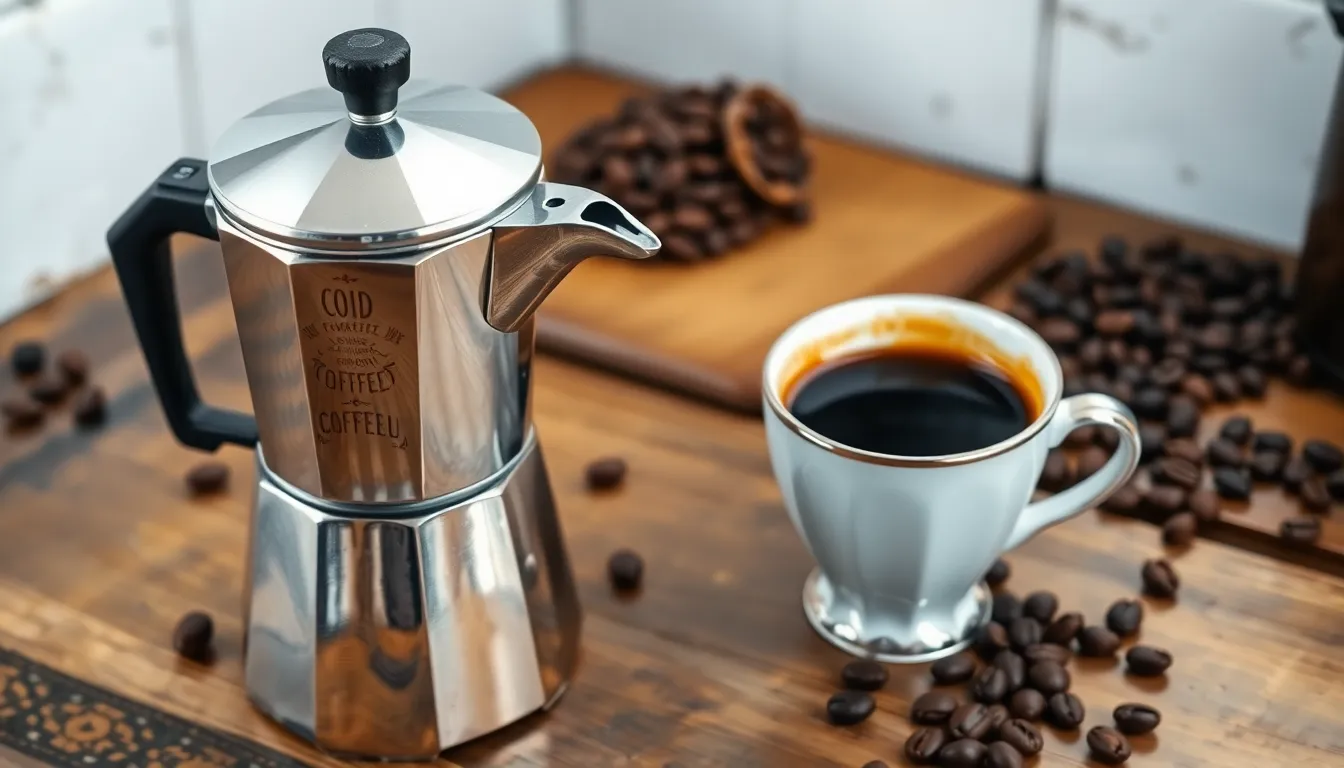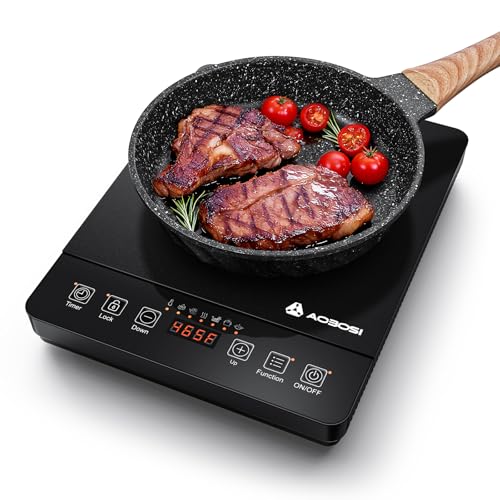Wondering about the moka pot caffeine content in your morning brew? That rich, robust espresso-like coffee from your stovetop companion packs quite the punch—but exactly how much caffeine are you consuming with each cup?
The moka pot, invented in Italy in 1933, has become a beloved brewing method for coffee enthusiasts worldwide. Its unique pressure brewing system extracts more caffeine than regular drip coffee but less than traditional espresso. When you’re trying to manage your daily caffeine intake while still enjoying that distinctive moka pot flavor, understanding exactly what’s in your cup becomes essential.
What Is a Moka Pot and How Does It Work
A Moka pot is an iconic Italian stovetop coffee maker designed by Alfonso Bialetti in 1933. This octagonal brewing device creates a rich, concentrated coffee that’s stronger than drip coffee but not quite as intense as espresso. Made typically of aluminum or stainless steel, Moka pots have become a staple in many households worldwide due to their reliability and distinctive brewing method.
The brewing process in a Moka pot relies on steam pressure. When heated on a stovetop, water in the bottom chamber boils, creating pressure that forces hot water up through the coffee grounds in the middle filter basket. This pressurized water extracts coffee compounds more efficiently than gravity-based methods like pour-over or drip coffee makers.
Moka pots consist of three main components: the bottom chamber (boiler) for water, a middle filter basket for ground coffee, and a top chamber where the brewed coffee collects. The design hasn’t changed significantly since its invention, testament to its effective engineering. The brewing temperature reaches approximately 200°F (93°C), extracting robust flavors from the coffee beans.
Many coffee enthusiasts appreciate Moka pots for their portability and independence from electricity. They’re compact enough for camping trips yet durable enough for daily use. The characteristic gurgling sound they make while brewing has become a morning ritual for countless coffee lovers around the industry.
Moka Pot Caffeine Content: The Numbers
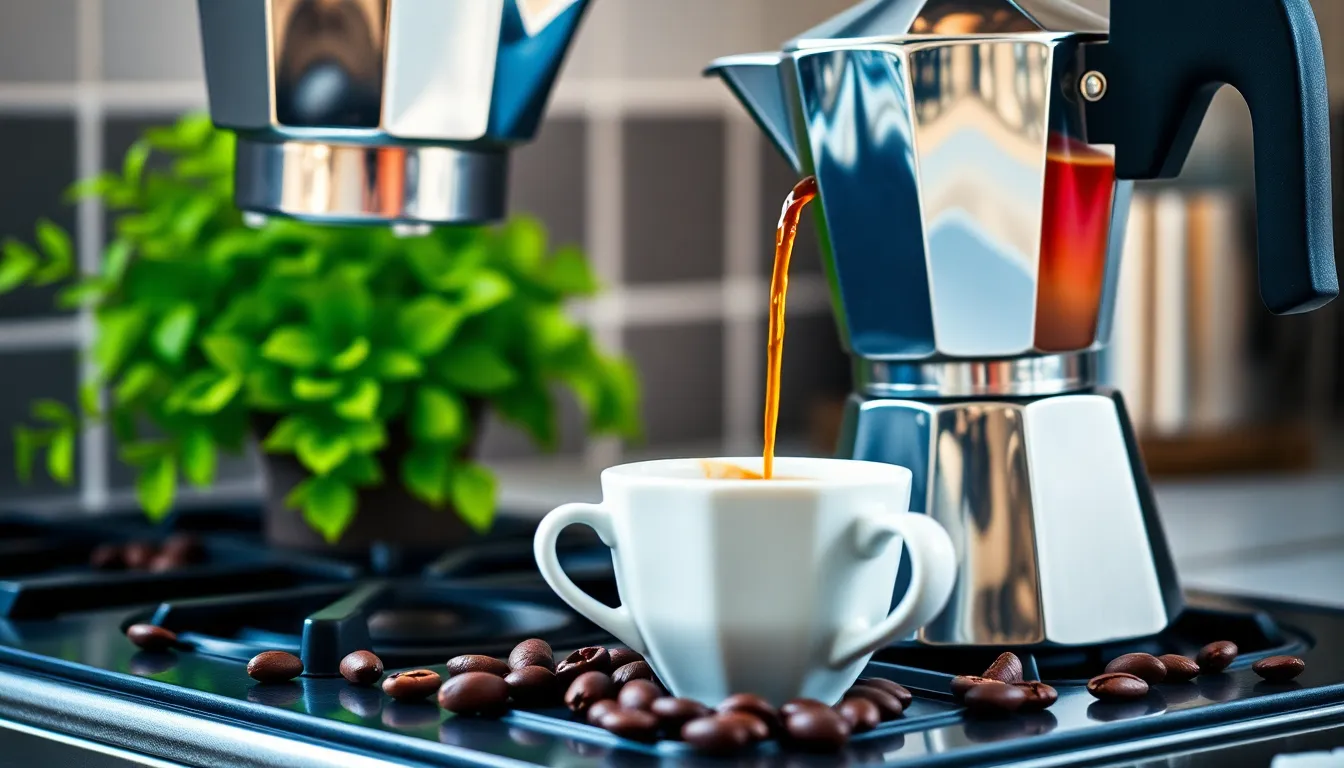
A standard 2 fl oz (about 60 ml) serving of moka pot coffee contains approximately 93 mg of caffeine. In a typical 50 ml “espresso cup” size, you’re getting around 93 mg of caffeine, which translates to about 157 mg of caffeine per 100 ml. Some studies have found even higher concentrations, with certain measurements showing up to 219 mg of caffeine per 100 ml, depending on exact brewing conditions.
Comparing Caffeine Levels to Other Brewing Methods
Moka pot coffee delivers significantly more caffeine than several popular brewing methods. Even though being nicknamed “stovetop espresso,” moka pots operate at much lower pressure (1-2 bars compared to espresso machines’ 9 bars), creating a different caffeine extraction profile. French press coffee contains only about one-third the caffeine of moka pot coffee per volume, with measurements showing 74 mg per 100 ml for French press versus 219 mg for moka pot. Traditional drip coffee typically contains less caffeine per volume than moka pot coffee due to the concentrated nature of the moka brewing process, though exact comparisons vary based on brew strength and coffee type.
Factors That Influence Moka Pot Caffeine Content
Brew time plays a crucial role in caffeine extraction, with longer brewing periods, especially in larger multi-cup moka pots, yielding higher caffeine content. Grind size affects extraction efficiency – using fine grounds (though not as fine as espresso grind) maximizes caffeine output. The coffee-to-water ratio, typically around 1:7 by weight, directly impacts your final caffeine concentration. Bean selection creates substantial variation in caffeine levels, as Robusta beans contain approximately twice the caffeine of Arabica varieties. Water temperature optimization at 90-95°C (194-203°F) ensures proper extraction of caffeine and flavor compounds. Pressure levels in moka pots (1-2 bars) extract caffeine differently than high-pressure espresso machines, contributing to their unique caffeine profile.
A typical 6-cup moka pot using 20 grams of coffee produces about 200-220 ml of coffee, with caffeine content proportional to your choice of beans, grind size, and brewing parameters. Your moka pot brew delivers a robust caffeine kick comparable to espresso but with distinct characteristics that coffee enthusiasts appreciate for both flavor and caffeine delivery.
How to Control Caffeine in Your Moka Pot
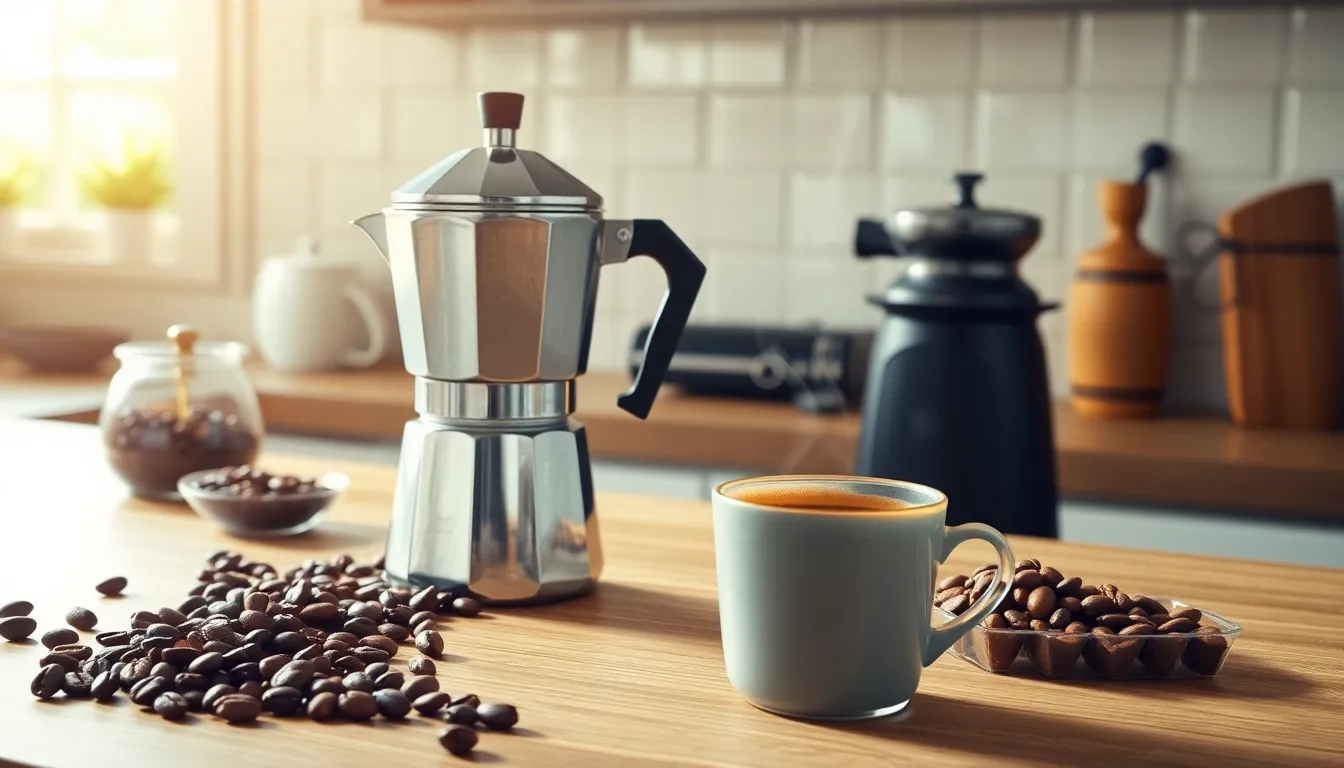
Controlling caffeine levels in your moka pot coffee starts with understanding key brewing variables. Several factors directly influence how much caffeine ends up in your cup, from bean selection to brewing techniques.
Choosing the Right Coffee Bean
Coffee bean variety dramatically affects caffeine content in your moka pot brew. Arabica beans contain approximately half the caffeine of Robusta beans, making them an excellent choice for lower-caffeine coffee. Robusta beans pack 2-3 grams of caffeine per 100 grams, potentially delivering 500-600 mg of caffeine per cup—a important increase compared to Arabica’s more moderate levels. Bean origin also plays a role in caffeine content, with different growing regions producing beans with varying natural caffeine levels. Single-origin Arabica beans typically offer more predictable and consistent caffeine content than blends containing Robusta. Many specialty coffee roasters specify bean types on their packaging, making it easier to select options aligned with your caffeine preferences.
Grind Size and Its Impact on Caffeine Extraction
Grind size functions as a critical control point for caffeine extraction in moka pot brewing. Fine grinds (though not as fine as espresso) optimize extraction while maintaining proper flow through the device. Coarser grinds result in under-extraction and less caffeine, while overly fine grinds can cause over-extraction, excessive caffeine, or pot clogging. The relationship between grind size and extraction efficiency directly impacts final caffeine content in your cup. Consistency in grinding ensures reproducible results from brew to brew. Most home coffee grinders offer adjustable settings that let you find the sweet spot for your preferred caffeine level—typically between medium and medium-fine for moka pots. Fresh grinding immediately before brewing also affects extraction efficiency, as pre-ground coffee loses volatile compounds that influence both flavor and extraction characteristics.
Additional Factors Affecting Caffeine Levels
Brewing time significantly impacts caffeine extraction, with typical moka pot brewing taking 3-5 minutes. Longer brewing times, especially when making larger batches, increase caffeine content per cup. Coffee-to-water ratio typically follows a 1:7 proportion by weight/volume in moka pots, with more coffee naturally resulting in higher caffeine concentration. Water temperature plays a crucial role, with optimal extraction occurring at 90-95°C (194-203°F). Hotter temperatures extract caffeine more efficiently but risk bitter flavors. The age of your coffee beans affects caffeine content minimally, though fresher beans provide better flavor profiles. Regular cleaning of your moka pot prevents buildup that can alter extraction patterns and caffeine levels over time.
Health Considerations of Moka Pot Caffeine Levels
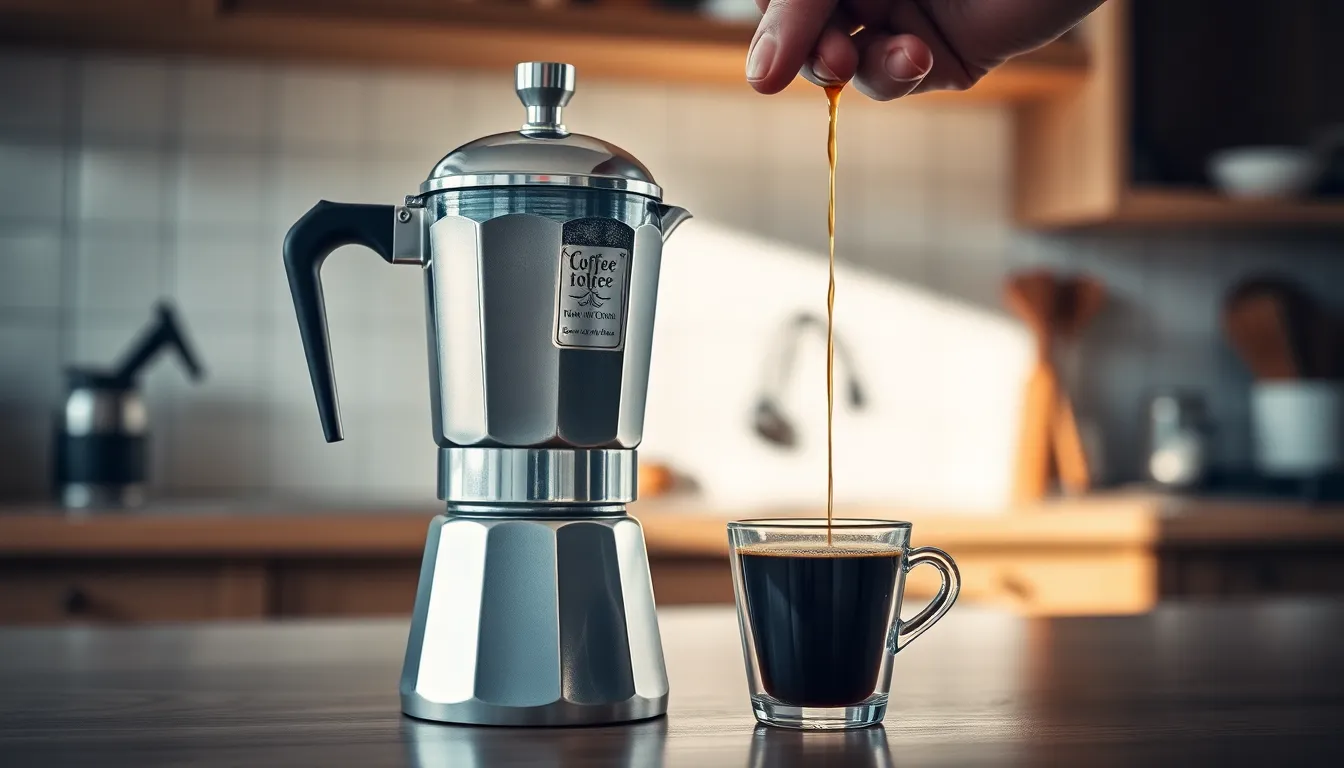
Moka pot coffee delivers a potent caffeine dose that affects your body differently than other brewing methods. With approximately 93 mg of caffeine per 2 fl oz serving, this concentrated brew packs nearly three times the caffeine punch of French press coffee by volume. Your body processes this higher concentration more rapidly, potentially leading to quicker onset of caffeine’s effects.
Individuals with caffeine sensitivity face particular challenges when enjoying moka pot coffee. The concentrated nature of the brew means even a small cup contains important caffeine, which can trigger unwanted symptoms in sensitive people. These reactions often include restlessness, increased heart rate, digestive discomfort, or anxiety when consumption exceeds personal tolerance levels.
Heart patients should approach moka pot coffee with caution due to caffeine’s known cardiovascular effects. Caffeine temporarily increases blood pressure and heart rate, creating potential risks for those with pre-existing heart conditions. Medical professionals typically recommend that patients with heart issues limit their caffeine intake and monitor their body’s response carefully.
Sleep quality suffers significantly from afternoon or evening consumption of high-caffeine moka pot coffee. Caffeine’s half-life ranges from 5-6 hours in most adults, meaning half the caffeine remains in your system many hours after drinking. A strong moka pot brew enjoyed at 4 PM still affects your nervous system at 10 PM, potentially disrupting sleep onset and reducing sleep quality.
Proper cleaning of your moka pot isn’t just about taste—it’s a critical safety consideration. Coffee residue can block the safety valve, creating dangerous pressure buildup during brewing. This blockage presents a genuine hazard, as the safety valve prevents excessive pressure that could otherwise cause the pot to explode. Regular maintenance includes disassembling and thoroughly cleaning all components after each use.
Moderation proves essential when incorporating moka pot coffee into your daily routine. Health authorities recommend limiting caffeine intake to 400 mg daily for most healthy adults. With moka pot coffee’s high concentration, this equates to approximately four 2 fl oz servings daily, though individual tolerance varies based on metabolism, body weight, and caffeine sensitivity.
Common Myths About Moka Pot Caffeine Content
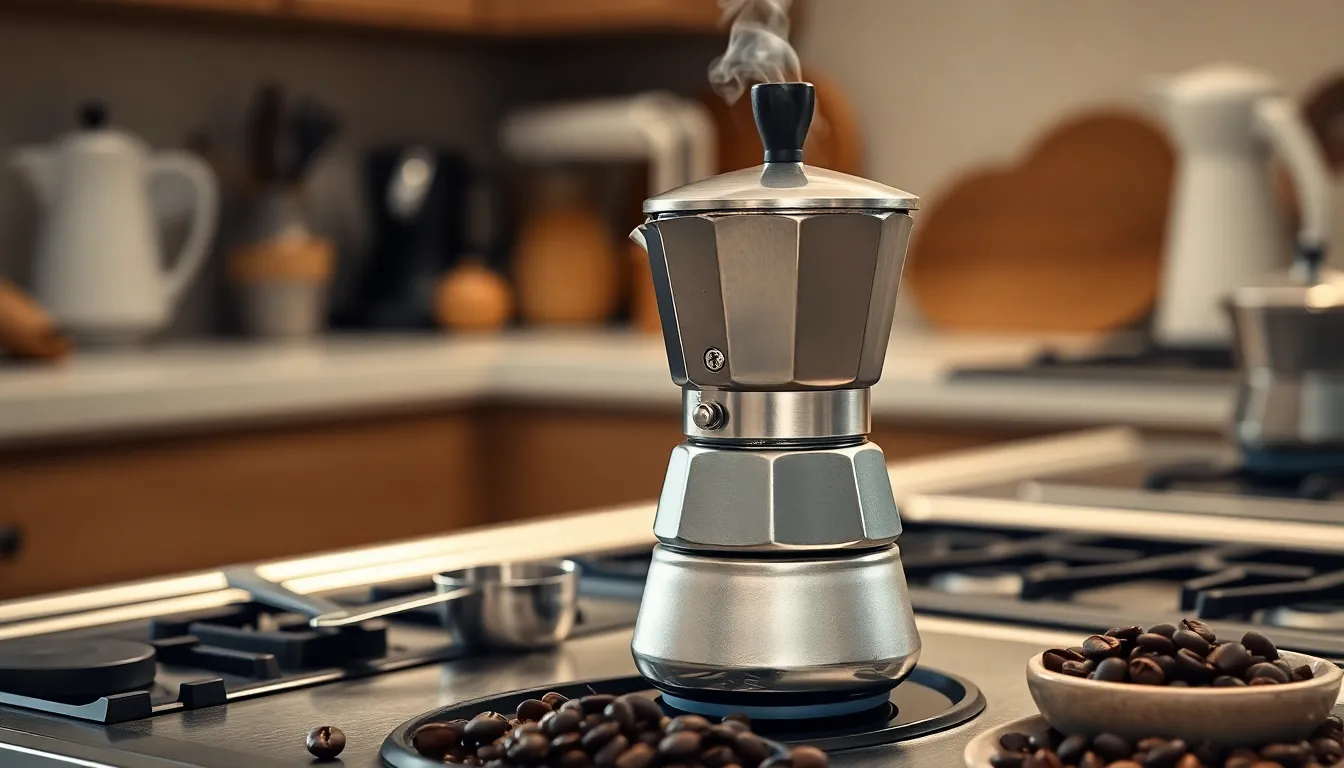
Myth 1: Moka Pot Coffee Has More Caffeine Than Espresso
Many coffee enthusiasts incorrectly assume that moka pot coffee contains more caffeine than traditional espresso. The truth is quite different—moka pot coffee actually contains less caffeine than espresso due to fundamental brewing differences. Espresso machines operate at approximately 9 bars of pressure, while moka pots function at only 1-2 bars, resulting in different extraction levels. This pressure differential creates a important impact on caffeine extraction, even though both beverages delivering strong, concentrated flavors.
Myth 2: Caffeine Content Remains Constant Regardless of Brewing Method
A common misconception suggests that caffeine levels in moka pot coffee remain fixed regardless of how you brew it. Research clearly demonstrates that caffeine content varies substantially based on several key factors. Grind size plays a crucial role—finer grounds typically yield higher caffeine content than coarser options. The type of beans you select also matters significantly, with Robusta beans containing approximately twice the caffeine of Arabica varieties. Coffee-to-water ratio, typically around 1:7 in moka pots, and brew time further influence the final caffeine concentration in your cup.
Myth 3: Smaller Moka Pots Produce Less Caffeine Per Serving
Many people believe that using a smaller moka pot automatically results in less caffeine per serving. This assumption isn’t entirely accurate. While smaller pots produce smaller volumes of coffee, the caffeine concentration per fluid ounce remains relatively consistent across pot sizes. Interestingly, larger moka pots often require longer brewing times, which can actually increase caffeine extraction per serving. University of Newcastle research confirms that moka pot coffee can contain around 219 mg of caffeine per 100 ml—significantly higher than the 74 mg found in the same volume of French press coffee, regardless of pot size.
Conclusion
Understanding your moka pot’s caffeine content empowers you to brew according to your preferences and needs. With approximately 93mg of caffeine per 2oz serving you’re getting a potent brew that falls between drip coffee and espresso.
By adjusting variables like bean selection grind size and brewing time you can customize your caffeine intake while still enjoying that distinctive moka pot flavor. Remember that Arabica beans offer less caffeine than Robusta and finer grinds extract more caffeine.
For most adults staying within the recommended 400mg daily caffeine limit means enjoying about four servings of moka pot coffee. Listen to your body and adjust accordingly especially if you have health concerns or caffeine sensitivity.
Your moka pot delivers a reliable caffeine kick with rich flavor that’s hard to match with other brewing methods.
Frequently Asked Questions
How much caffeine is in moka pot coffee?
A standard 2 fl oz serving of moka pot coffee contains approximately 93 mg of caffeine, though this can vary. Some studies show levels as high as 219 mg per 100 ml depending on brewing conditions. This places moka pot coffee higher in caffeine than drip coffee but lower than traditional espresso.
Is moka pot coffee stronger than regular drip coffee?
Yes, moka pot coffee is stronger than regular drip coffee in both flavor and caffeine content. A typical moka pot brew contains approximately 100-150 mg of caffeine per 8 oz cup, while drip coffee averages 65-120 mg. The pressure brewing method creates a richer, more concentrated coffee similar to espresso.
How does a moka pot work?
A moka pot works using steam pressure. When heated, water in the bottom chamber creates steam that builds pressure, forcing the hot water up through the coffee grounds in the middle basket and into the top chamber. This pressure extraction method efficiently draws out coffee compounds, creating a concentrated brew with distinctive flavor characteristics.
Can I reduce the caffeine in my moka pot coffee?
Yes, you can reduce caffeine by using Arabica beans instead of Robusta (which have about half the caffeine), using a coarser grind, shortening brew time, adjusting your coffee-to-water ratio, or brewing at slightly lower temperatures. You can also mix regular coffee with decaffeinated beans to reduce caffeine while maintaining flavor.
Is moka pot coffee the same as espresso?
No, moka pot coffee is not the same as espresso. While both are concentrated and rich, moka pots brew at 1-2 bars of pressure compared to espresso machines’ 9+ bars. This results in less crema and slightly lower caffeine concentration. Moka pot coffee offers an espresso-like experience but with its own distinctive characteristics.
How many cups of moka pot coffee can I safely drink per day?
Most health authorities recommend limiting caffeine intake to 400 mg daily for healthy adults. Since a 2 fl oz serving of moka pot coffee contains about 93 mg of caffeine, this translates to roughly four servings per day. However, individual tolerance varies, and those with health conditions should consult their doctor.
Does the size of the moka pot affect caffeine content?
The size of the moka pot doesn’t affect the concentration of caffeine per volume, but larger pots produce more coffee overall. The caffeine concentration remains consistent regardless of pot size. However, larger pots may experience slightly longer brewing times, which could marginally increase caffeine extraction.
How should I clean my moka pot to ensure consistent caffeine levels?
Clean your moka pot after each use by disassembling it and rinsing with hot water (avoid soap as it can affect flavor). Periodically deep clean by soaking in a solution of water and white vinegar to remove mineral deposits and coffee oils. Regular cleaning prevents buildup that can affect brewing pressure and extraction efficiency, ensuring consistent caffeine levels.
Will drinking moka pot coffee late in the day affect my sleep?
Yes, consuming moka pot coffee in the afternoon or evening can disrupt sleep patterns. Caffeine has a half-life of 5-6 hours, meaning half the caffeine remains in your system that long after consumption. The concentrated nature of moka pot coffee delivers caffeine quickly into your bloodstream, potentially affecting sleep quality even hours later.
Are there health risks associated with moka pot coffee’s caffeine content?
For most healthy adults, moderate consumption of moka pot coffee poses minimal risks. However, individuals with caffeine sensitivity, heart conditions, anxiety disorders, or certain medications should be cautious. The concentrated nature of moka pot coffee means its effects can be felt more quickly than regular coffee, potentially amplifying side effects in sensitive individuals.

